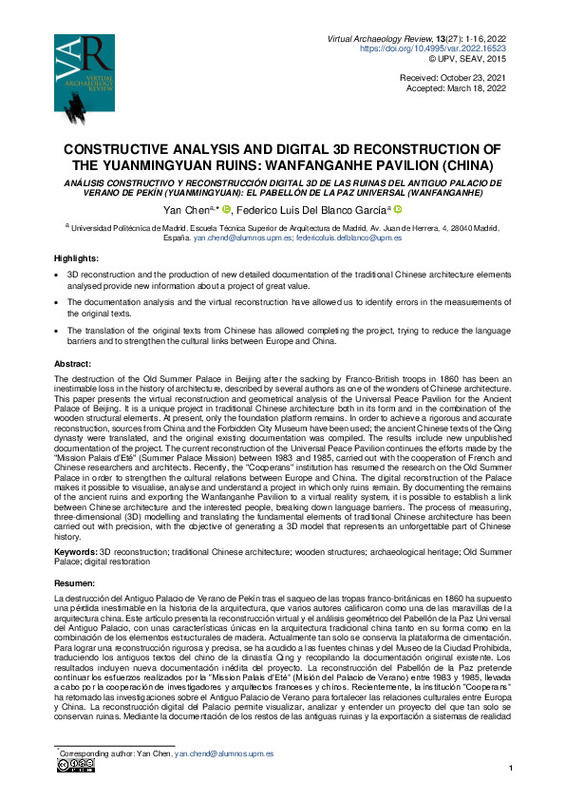Aira, J.R., Cabo M,C., del-Blanco F.L., & Gonzalo L. (2022). Puentes de madera con estructura recíproca. Análisis comparativo del puente tradicional chino y el puente de Leonardo. Informes de la Construcción, 74(565), 1-10. https://doi.org/10.3989/ic.85874
Aparicio-Resco, P., García Álvarez-Busto, A., Muñiz-López, I., & Fernández-Calderon, N. (2021). Reconstrucción virtual en 3D del castillo de Gauzón (Castrillón, Principado de Asturias). Virtual Archaeology Review, 12(25), 158-176. https://doi.org/10.4995/var.2021.14940
Aparicio D., & del-Blanco F.L. (2022). Design of immersive experiences for a utopian city. Graphic and virtual reconstruction of “The Walking City”, Archigram. EGA Expresión Gráfica Arquitectónica, 27(44), 98-109. https://doi.org/10.4995/ega.2022.14305
[+]
Aira, J.R., Cabo M,C., del-Blanco F.L., & Gonzalo L. (2022). Puentes de madera con estructura recíproca. Análisis comparativo del puente tradicional chino y el puente de Leonardo. Informes de la Construcción, 74(565), 1-10. https://doi.org/10.3989/ic.85874
Aparicio-Resco, P., García Álvarez-Busto, A., Muñiz-López, I., & Fernández-Calderon, N. (2021). Reconstrucción virtual en 3D del castillo de Gauzón (Castrillón, Principado de Asturias). Virtual Archaeology Review, 12(25), 158-176. https://doi.org/10.4995/var.2021.14940
Aparicio D., & del-Blanco F.L. (2022). Design of immersive experiences for a utopian city. Graphic and virtual reconstruction of “The Walking City”, Archigram. EGA Expresión Gráfica Arquitectónica, 27(44), 98-109. https://doi.org/10.4995/ega.2022.14305
Arayici, Y., Counsell, J., Mahdjoubi, L., Nagy, G. A., Hawas, S., & Dweidar, K. (Eds.) (2017). Heritage building information modelling. Abingdon: Routledge. Taylor & Francis. https://doi.org/10.4324/9781315628011
Banfi, F., Brumana, R., & Stanga, C. (2019). Extended reality and informative models for the architectural heritage: from scan-to-BIM process to virtual and augmented reality. Virtual Archaeology Review, 10(21), 14–30. https://doi.org/10.4995/var.2019.11923
Banfi, F. (2020). HBIM, 3D drawing and virtual reality for archaeological sites and ancient ruins. Virtual Archaeology Review, 11(23), 16-33. https://doi.org/10.4995/var.2020.12416
Brumana, R., Stanga, C., & Banfi, F. (2021). Models and scales for quality control: toward the definition of specifications (GOA-LOG) for the generation and re-use of HBIM object libraries in a Common Data Environment. Applied Geomatics, 14, 151-179. https://doi.org/10.1007/s12518-020-00351-2
Catmull, E., & Clark, J. (1978). Recursively generated B-spline surfaces on arbitrary topological meshes. Computer-Aided Design, 10(6), 350. https://doi.org/10.1016/0010-4485(78)90110-0
Cooperans Institution (2021). Yuanmingyuan – Europe. Retrieved October 18, 2021, from https://www.yuanmingyuan.eu/en/home/
del Blanco García, F. L. (2022). Reconstructing Pérez Piñero’s Anoeta Velodrome. Nexus Network Journal, 24(1), 1-22. https://doi.org/10.1007/s00004-022-00590-3
del-Blanco, F. L. (2021). Virtual reconstruction and geometric analysis of Félix Candela’s inverted umbrellas for The Villahermosa Cathedral. Disegnarecon, 14(27), 1–14. https://doi.org/10.20365/disegnarecon.27.2021.10
del-Blanco, F. L., & García Ríos, I. (2018). Fernando Higueras y Félix Candela en un retorno a la geometría de paraguas invertidos. Análisis y reconstitución gráfica del aeropuerto de Murcia, 1983. EGA Expresión Gráfica Arquitectónica, 23(32), 232–243. https://doi.org/10.4995/ega.2018.9813
del-Blanco, F. L. & García Ríos, I. (2017). Las cúpulas de Félix Candela. Análisis y reconstitución de las instalaciones deportivas de la Universidad Brown, 1965-1972. EGA Expresión Gráfica Arquitectónica, 22(29), 228–239. https://doi.org/10.4995/ega.2017.7358
Duanmu, H. (2008). New Evidence of the Yuanmingyuan Garden – Wanfanganhe. Palace Museum Journal, 2.
Garcia, K. (2021). Advances in Real-Time Rendering in Games. Siggraph 2021. https://www.advances.realtimerendering.com/s2021/index.html
Gabaldón Guzmán, J. (2018). El jardín chino a través de William Chambers. Un análisis compositivo. (Master’s thesis). Universidad Politécnica de Madrid, Spain. https://oa.upm.es/49544/
Gironacci, I. M. (2021). State of the Art of Extended Reality Tools and Applications in Business. In L. Dall'Acqua, & I. Gironacci (Eds.), Transdisciplinary Perspectives on Risk Management and Cyber Intelligence (pp. 105-118). IGI Global. https://doi.org/10.4018/978-1-7998-4339-9.ch008
Ioannides, M., Magnenat-Thalmann, N., & Papagiannakis, G. (2017). Mixed Reality and Gamification for Cultural Heritage. Cham: Springer. https://doi.org/10.1007/978-3-319-49607-8
Karis, B., Stubbe, R., & Wihlidal, G. (2021). Nanite. A deep dive. Siggraph 2021. https://s2021.siggraph.org/a-deep-dive-into-unreal-engines-5-nanite/
Kuo, C. L., Cheng, Y. M., Lu, Y. C., Lin, Y. C., Yang, W. B., & Yen, Y. N. (2018). A Framework for Semantic Interoperability in 3D Tangible Cultural Heritage in Taiwan. In Euro-Mediterranean Conference (pp. 21–29). Cham: Springer. https://doi.org/10.1007/978-3-030-01765-1_3
He, Y., Gao, M., & Shang, J. (2013). A Virtual Reconstruction Methodology for Archaeological Heritage in East Asia – Practical Experience from the Re-relic Program in China. Virtual Archaeology Review, 4(9), 93. https://doi.org/10.4995/var.2013.4253
Lee, H. (2009). The Ruins of Yuanmingyuan: Or, How to Enjoy a National Wound. Modern China, 35(2), 155–190. https://doi.org/10.1177/0097700408326911
Liang, S. (2006). Qing Structural Regulations (8a). Beijing: Tshinghua University.
Liu, R. (2015). Studies on the Nine Poems of Wangfanganhe: Interior space in drawing, Models and Documents. Beijing: Tsinghua University.
Liu, R., Liu, C., & Zhao, B. (2016). Re-analysis of Wanfanganhe’s nine wing space. Palace Museum Journal, 2.
Ma, B. (1991). Wood Construction Technology of Chinese Ancient Architecture. Beijing: Science Press.
Parrinello, S., Bercigli, M., & Bursich, D. (2017). From survey to 3D model and from 3D model to “videogame”. The virtual reconstruction of a Roman Camp in Masada, Israel. Disegnarecon, 10(19), 11.1–11.19.
Pan, G., & He, J. (2017). Interpretacion de Yingzhao Fashi (2nd ed.). Nanjing: Southeast University.
Pybus, C., Graham, K., Doherty, J., Arellano, N., & Fai, S. (2019). New realities for Canada's Parliament: a workflow for preparing heritage BIM for game engines and virtual reality. International Archives of the Photogrammetry, Remote Sensing and Spatial Information Sciences, XLII-2/W15, 945–952. https://doi.org/10.5194/isprs-archives-XLII-2-W15-945-2019
Qian, Z. (2009). History of Chinese Architecture Art. Jiangsu: Jiangsu’s people.
Schulze, J. (2021). Immersive Visualisation of MRI data for surgical planning. In Immersive visualisation for science research, art and education. SIGGRAPH and SIGGRAPH Asia Birds of a Feather Session. Retrieved June 2, 2021, from https://immersive-visualisation-bof.org/
Souza, E. (2021). From Handcrafted Stone to 3D Printing: The Technological and Material Evolution of Gaudí’s Sagrada Familia. Retrieved June 2, 2021, from https://www.plataformaarquitectura.cl/cl/964192/de-la-piedra-artesanal-a-la-impresion-3d-evolucion-tecnologica-y-material-de-la-sagrada-familia-de-gaudi
Trunfio, M., Lucia, M. D., Campana, S., & Magnelli, A. (2021). Innovating the cultural heritage museum service model through virtual reality and augmented reality: the effects on the overall visitor experience and satisfaction. Journal of Heritage Tourism, 17(1), 1-19. https://doi.org/10.1080/1743873X.2020.1850742
Wang, X. (1996). Dictionary of Ancient Chinese Architecture. Shanxi: Shanxi’s people.
Yao, C. (1986). Building standards and sources. Beijing: China Architecture & Building Press.
Zhu, Q. (2004). Model of Wanfanganhe. Palace Museum Journal, 3, 43-44. https://www.dpm.org.cn/building/talk/224398.html
[-]









